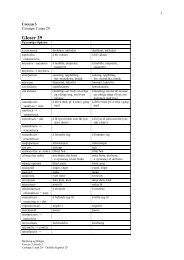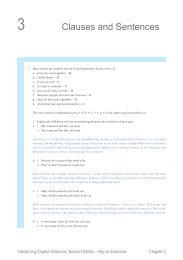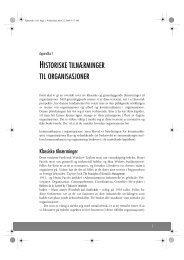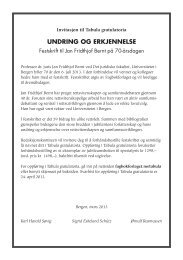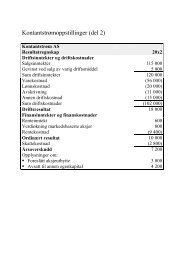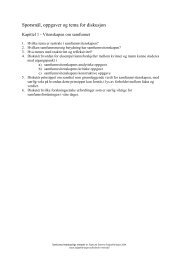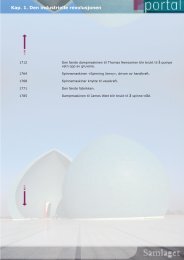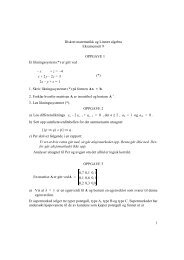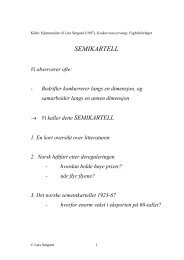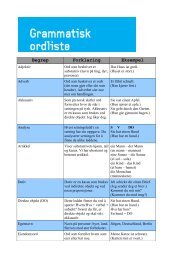price discrimination in the airline industry - Fagbokforlaget
price discrimination in the airline industry - Fagbokforlaget
price discrimination in the airline industry - Fagbokforlaget
You also want an ePaper? Increase the reach of your titles
YUMPU automatically turns print PDFs into web optimized ePapers that Google loves.
Version<strong>in</strong>g implies that <strong>the</strong> airl<strong>in</strong>e offers different versions of its product, and <strong>the</strong>consumer can choose between <strong>the</strong>m. The high quality version is a flexible ticket, where<strong>the</strong> passenger can reschedule and even cancel <strong>the</strong> flight whenever it wants. The lowquality version is a restricted ticket, typically with a Saturday night stay-over andadvance purchase requirement. In <strong>the</strong> <strong>the</strong>oretical literature <strong>the</strong> restricted ticket is called adamaged product. The airl<strong>in</strong>e offers a damaged product because it <strong>the</strong>n makes this lowqualityversion less attractive for <strong>the</strong> bus<strong>in</strong>ess traveler. It enables <strong>the</strong>m to charge a high<strong>price</strong> for <strong>the</strong> flexible ticket, and still serve <strong>the</strong> passengers with a low will<strong>in</strong>gness to payby offer<strong>in</strong>g <strong>the</strong>m a damaged product. This leads to <strong>in</strong>creased output, and <strong>in</strong>creased outputmay lead to higher frequency.Apparently, damag<strong>in</strong>g a product is detrimental to welfare s<strong>in</strong>ce <strong>the</strong> airl<strong>in</strong>es offeran <strong>in</strong>ferior product. But we argue that <strong>the</strong> net effect of version<strong>in</strong>g <strong>in</strong> <strong>the</strong> airl<strong>in</strong>e <strong>in</strong>dustry isprobably positive. The product damag<strong>in</strong>g is harmful for those who do not buy <strong>the</strong> productbut ra<strong>the</strong>r <strong>the</strong> high quality product – <strong>the</strong> bus<strong>in</strong>ess travelers – but probably not veryharmful to those who actually buy that version. For example, a leisure traveler mighttravel dur<strong>in</strong>g <strong>the</strong> weekend and <strong>the</strong>n a Saturday night stay-over is not harmful at all.Moreover, <strong>the</strong> alternative to version<strong>in</strong>g might be that no low quality version would beoffered. If so, <strong>the</strong> segment with low will<strong>in</strong>gness to pay would have been hurt by a shiftfrom version<strong>in</strong>g to no version<strong>in</strong>g. F<strong>in</strong>ally, empirical studies <strong>in</strong>dicate that competitionleads to a cheaper damaged product. S<strong>in</strong>ce this segment is typically quite <strong>price</strong> elastic, itwould lead to a substantial output <strong>in</strong>crease and <strong>the</strong>reby a substantial welfare <strong>in</strong>crease.Therefore, we conclude that version<strong>in</strong>g is welfare improv<strong>in</strong>g, especially <strong>in</strong> a competitivesett<strong>in</strong>g.Discount to large consumers is an example of third degree <strong>price</strong> <strong>discrim<strong>in</strong>ation</strong>. Ashift to this k<strong>in</strong>d of <strong>price</strong> <strong>discrim<strong>in</strong>ation</strong> would imply that some groups face a lower <strong>price</strong>and some groups a higher <strong>price</strong>. It can easily be shown that such a k<strong>in</strong>d of <strong>price</strong><strong>discrim<strong>in</strong>ation</strong> can be detrimental to welfare. The ga<strong>in</strong> from those who face a lower <strong>price</strong>might be outweighed by <strong>the</strong> loss for those who face a higher <strong>price</strong>. In a monopoly sett<strong>in</strong>gwe expect that <strong>the</strong> airl<strong>in</strong>e sets a high <strong>price</strong> for <strong>the</strong> segment with <strong>price</strong> <strong>in</strong>elastic demand,which is a <strong>price</strong> structure that m<strong>in</strong>imizes <strong>the</strong> welfare loss from such <strong>price</strong> <strong>discrim<strong>in</strong>ation</strong>.In a competitive sett<strong>in</strong>g, though, it can be different.© Steen and Sørgard 26



